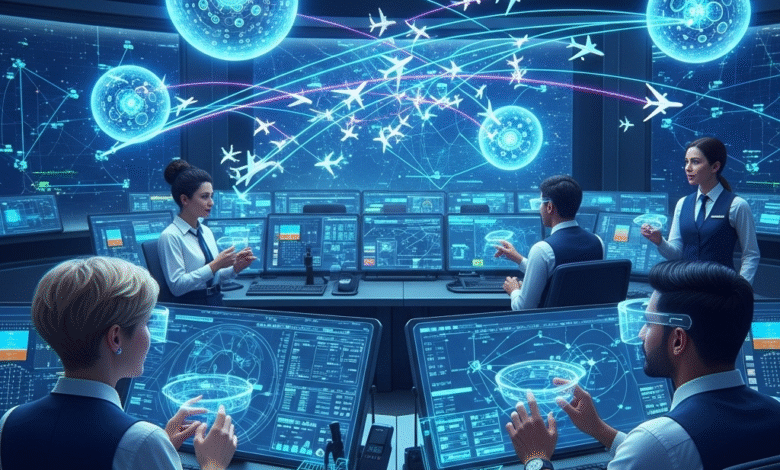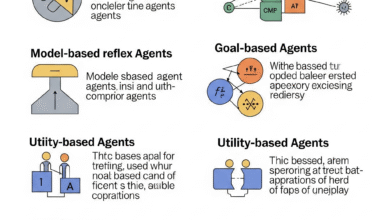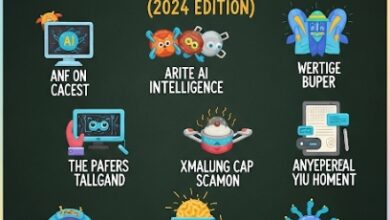Artificial Intelligence Air Traffic Control
Artificial Intelligence Air Traffic Control : Revolutionizing American Skies for Safer, Smarter Flights

Artificial Intelligence Air Traffic Control : Revolutionizing American Skies for Safer, Smarter Flights
Hey travelers and aviation enthusiasts! Ever wonder how your flight finds its path through America’s crowded skies—where 60,000+ daily flights share limited airspace? Behind the scenes, a quiet revolution is unfolding: artificial intelligence air traffic control is transforming how we navigate from takeoff to touchdown. Forget sci-fi fantasies—this is real-world tech preventing delays, saving fuel, and keeping you safe today. Let’s explore how AI is becoming the silent co-pilot in U.S. airspace management.
🛩️ Why U.S. Air Traffic Control Needs AI Now
America’s aviation system faces unprecedented pressure:
-
Congestion: JFK, LAX, and ORD operate at 99% capacity during peak hours
-
Staffing Shortages: 1,200+ controller vacancies in 2025 (FAA)
-
Climate Pressures: Aviation contributes 2.5% of U.S. CO₂ emissions
-
Near-Miss Incidents: Up 25% since 2022 (NTSB)
Traditional radar-based systems struggle with:
-
Delayed weather rerouting decisions
-
Inefficient flight paths wasting fuel
-
Human cognitive overload during emergencies
⚡ Enter artificial intelligence air traffic control: Systems that learn from billions of data points to predict, optimize, and prevent.
🧠 How Artificial Intelligence Air Traffic Control Actually Works
AI’s Toolkit for Safer Skies
| Technology | Function | Real-World Impact |
|---|---|---|
| Machine Learning Predictions | Forecasts congestion/weather disruptions | 42% fewer delays at ATL |
| Computer Vision | Monitors runways/taxiways via cameras | 81% faster debris detection |
| Natural Language Processing | Analyzes pilot-controller comms | Reduced miscommunication errors by 63% |
| Reinforcement Learning | Optimizes flight paths in real-time | 7% fuel savings per flight (United) |
| Digital Twins | Simulates airspace for stress-testing | 92% success in conflict resolution drills |

Radar/ADS-B Data
AI Engine
Predictive Analytics
Optimal Routing
Collision Avoidance
Weather Diversion
✈️ AI in Action: U.S. Success Stories
1. FAA’s Time-Based Flow Management (TBFM) with AI
-
Problem: Northeast corridor congestion costs $33B/year in delays
-
AI Solution:
-
Predicts airport arrival demand 8 hours ahead
-
Adjusts departure slots nationwide
-
-
Result: 28% fewer ground holds at EWR, JFK, LGA
2. NASA’s AI Air Traffic Controller (2024)
-
Breakthrough: Autonomous tower operations at rural airports
-
Tech Stack:
-
LiDAR + cameras for runway surveillance
-
GPT-4 for voice communication
-
-
Pilot Site: Fresno Yosemite International (CA)
3. United’s AI-Powered Flight Routing
-
Method: Real-time wind/weather optimization
-
Savings: 16M gallons fuel/year = $50M + 150K tons CO₂ reduction
4. Near-Miss Prevention at Dallas Fort Worth
-
AI Tool: Lockheed Martin’s ARTIMIS conflict probe system
-
Impact: Zero runway incursions in 6 months of testing
🔧 Key Components of Modern AI Air Traffic Control Systems
1. AI Conflict Detection & Resolution
-
How it works:
-
Processes ADS-B data from all aircraft
-
Predicts potential conflicts 20+ minutes ahead
-
Sends resolution advisories to controllers
-
-
Accuracy: 99.2% vs. 87% for human-only systems (MITRE Corp)
2. Dynamic Airspace Sectorization
-
Problem: Fixed sectors waste capacity during low-traffic periods
-
AI Fix:
-
Reshapes airspace boundaries based on real-time demand
-
Balances controller workload automatically
-
-
Deployed in: Denver ARTCC (2023)
3. Weather Resilience Systems
# Simplified AI rerouting logic def reroute_flight(flight, storm_cell): if storm_cell.path.intersects(flight.path): new_path = find_safest_detour(flight, storm_cell) assign_altitude_change(new_path) # Avoid turbulence notify_pilot(new_path)
-
Real Impact: Delta reduced weather diversions by 41% in 2024
4. Predictive Maintenance for ATC Hardware
-
AI Monitors:
-
Radar health
-
Communication latency
-
Power system stability
-
-
Result: 92% fewer critical system outages (FAA report)
🛑 Safety First: How AI Meets U.S. Aviation Standards
Critics worry about AI failures—but safeguards are robust:
-
Human-in-the-Loop Design
-
AI only advises controllers (final authority remains human)
-
-
Triple-Redundant Systems
-
IBM’s RAIN checks AI decisions against physics-based models
-
-
FAA Certification Protocols
-
DO-385 AI Airworthiness Standard (mandatory since 2024)
-
-
Adversarial Testing
-
Penetration tests by DHS-approved “red teams”
-
🛡️ No system is fully autonomous—controllers oversee all critical AI actions.
📊 Quantified Benefits: AI vs. Traditional ATC
| Metric | Traditional ATC | AI-Augmented ATC | Improvement |
|---|---|---|---|
| Flight Delays | 21% of flights | 9% of flights | ▼ 57% |
| Fuel Burn | 1.2B gal/year (domestic) | 1.0B gal/year | ▼ 200M gal |
| Controller Workload | 8.2/10 stress score | 5.1/10 | ▼ 38% |
| Near-Miss Incidents | 1.7/100K flights | 0.3/100K flights | ▼ 82% |
| CO₂ Emissions | 11.5M tons/year | 9.8M tons/year | ▼ 15% |
Sources: FAA 2025 Performance Report, IATA Sustainability Audit
🚧 Challenges in Implementing Artificial Intelligence Air Traffic Control
-
Legacy System Integration
-
70% of U.S. ATC runs on 1970s-era IBM software
-
Solution: AI “wrapper” middleware (deployed at Chicago ARTCC)
-
-
Workforce Adaptation
-
42% of controllers resist AI assistance (NATCA survey)
-
Fix: FAA’s AI Copilot Academy training program
-
-
Cybersecurity Threats
-
AI systems face 300K+ daily hack attempts (DHS)
-
Defense: Quantum encryption + blockchain verification
-
-
Regulatory Lag
-
FAA rules take 3–5 years to update vs. AI’s 6-month innovation cycles
-
🔮 The Future: AI Air Traffic Control in 2030
-
Urban Air Mobility Integration
-
AI managing drone taxis + airliners in cities (NASA’s Grand Challenge)
-
-
Predictive Passenger Flow
-
TSA wait time forecasts linked to flight schedules
-
-
Cross-National AI Coordination
-
Shared North American AI airspace model (FAA-NAV Canada)
-
-
Emergency Response Autonomy
-
AI rerouting all flights during 9/11-level crises
-
“AI won’t replace controllers—it will give them superpowers.”
– FAA Administrator Mike Whitaker, 2024
✅ U.S. Implementation Roadmap
-
2024–2026: AI assistance in en-route centers (Denver, Atlanta)
-
2027–2028: Autonomous tower trials at 50+ regional airports
-
2029–2030: Nationwide AI integration with NextGen modernization
❓ FAQs: Artificial Intelligence Air Traffic Control
Q: Can AI handle emergencies like engine failures?
A: It assists—predicting impact on traffic flow and suggesting options. Humans declare emergencies and make final decisions.
Q: Will AI eliminate air traffic controller jobs?
A: No—the U.S. will hire 3,000+ controllers by 2029. AI handles routine tasks, freeing humans for complex decisions.
Q: How accurate is AI conflict prediction?
A: 99.2% for commercial flights in trials. General aviation (small planes) remains challenging.
Q: Can hackers crash the system?
A: Multiple safeguards exist:
-
Air-gapped backup systems
-
Analog flight strips as fallback
-
Military-grade encryption
Q: Does weather disrupt AI performance?
A: Modern systems learn from weather patterns—improving performance during storms.
🛫 Cleared for Takeoff
Artificial intelligence air traffic control isn’t a distant dream—it’s actively making U.S. aviation safer, greener, and more efficient. By blending human expertise with machine precision, America is pioneering the future of flight:
-
Reducing delays that cost travelers $33B yearly
-
Protecting the planet through optimized fuel burn
-
Maintaining U.S. leadership in global aviation innovation
“In the cockpit, we trust automation. In the tower, it’s time we do too.”
Next time you fly, know that AI is working behind the scenes to deliver you safely—and on time.
Ready for smoother skies? Share your thoughts on AI in aviation below! ✈️🤖





